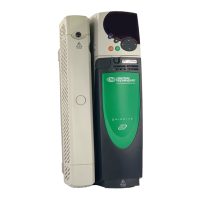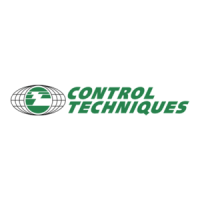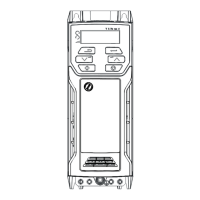Menu 3
Closed-loop
Parameter
structure
Keypad and
display
Parameter
x.00
Parameter
description format
Advanced parameter
descriptions
Macros
Serial comms
protocol
Electronic
nameplate
Performance
Feature look-
up table
56 Unidrive SP Advanced User Guide
www.controltechniques.com Issue Number: 7
To analyse the performance of the speed controller it may be represented as an s-domain model as shown below.
Where:
Kc is the conversion between the speed controller output and torque producing current. A value of unity at the input to this block gives a torque
producing current equivalent to the rated current of the drive. The drive automatically compensates the torque producing current for flux variations in
field weakening, and so Kc can be assumed to have a constant value. Kc is equal to the rated drive current (see Menu 4 for value of Rated drive
current for each drive size).
Kt is the torque constant of the motor (i.e. torque in Nm per amp of torque producing current). This value is normally available for a servo motor from
the manufacturer, however for induction motors the value must be calculated from
Kt = Motor rated torque / Motor rated torque producing current
= Motor rated torque / √(Motor rated current
2
- No load current
2
)
L(s) is the transfer function of the load.
The s-domain system above may be used to determine the performance of systems with a relatively low bandwidth. However, the real drive system
also includes non-ideal delays due to the torque controller response, and speed measurement and control delays. These delays, which can be
approximated with a simple unity gain transport delay (T
delay
) as shown below, should be taken into account for more accurate results.
The table below shows the delays that should be used with different switching frequencies assuming that the current controllers have been set up
correctly.
The speed controller gains used in previous Unidrive products were in internal drive units. Conversion between the previous internal units and the SI
units used in this product are given in the table below.
Switching
frequency (kHz)
Sample period for
speed feedback (µs)
Speed controller
delay (µs)
Current/torque
controller delay (µs)
Total delay (µs)
3 125 167 1160 1452
4 125 125 875 1125
6 125 83 581 789
8 125 125 625 875
12 125 83 415 623
16 125 125 625 875
Gain Conversion from previous internal units to new SI units
Kp Kp_old / 17103
Ki Ki_old / 94.41
Kd Kd_old / 46376
Kp
Ki 1/s
Kc Kt L(s)
+
_
+
+
w*(s)
rads
-1
w(s)
Speed controller
Ki.Kd
_
rads
-1
Kp+Ki/s
Ki.Kd
Kc.Kt L(s)
+
_
+
_
w*(s)
w(s
T
delay
http://nicontrols.com

